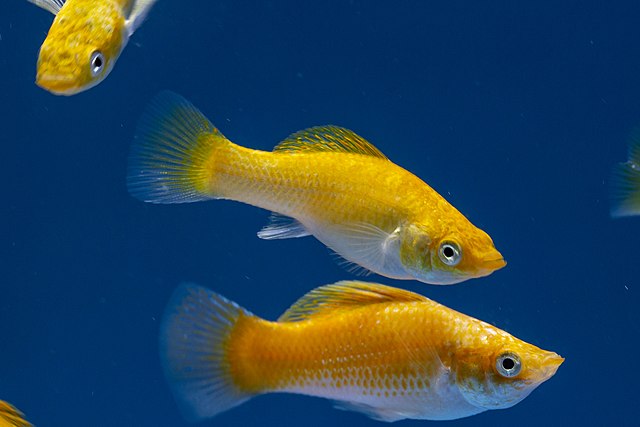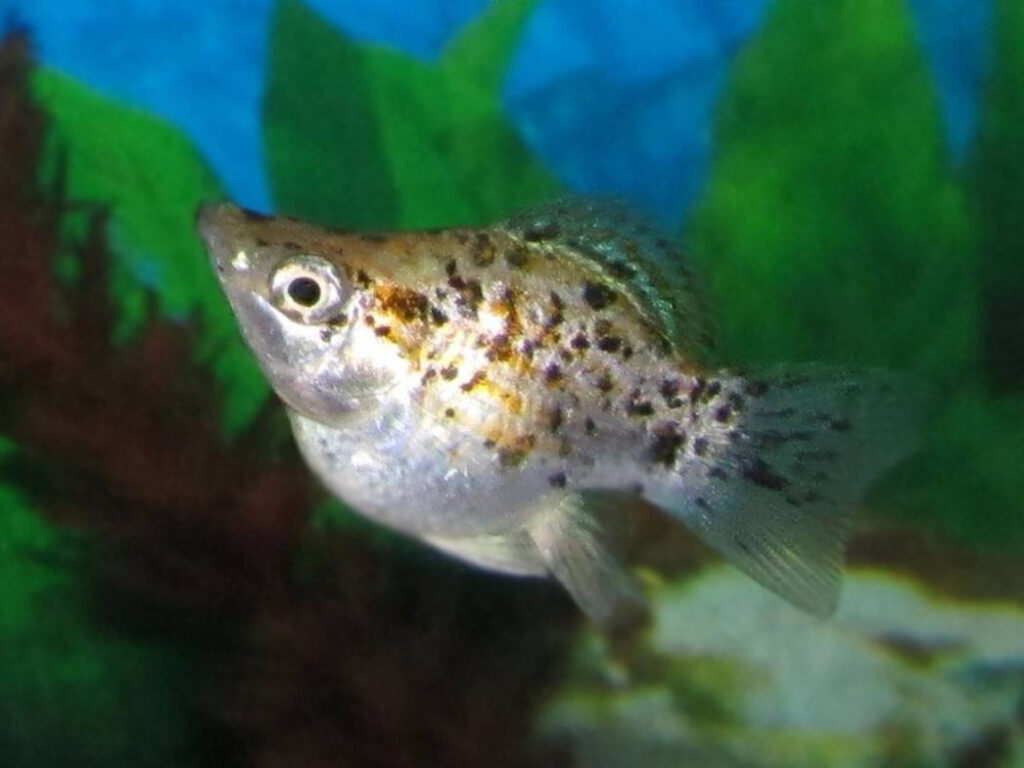The molly fish is found in freshwater, brackish water and even in saltwater environments. They were first discovered in the 1820s and adopted into the aquarium hobby in 1899. Due to select breeding, this fish comes in a variety of sizes, shapes and colors. Here are 8 facts about this all time freshwater aquarium favorite species:
1. Are Molly Fish Aggressive?
These fish are widely labeled as docile, community fish. However, they are also known to “pick” on each other and even sometimes on their tankmates. Now what do I mean by that exactly? The “picking on each other” behavior is usually due to their courtship practices. During this period of time, the males can be seen chasing the females. Molly fish reproduce on a regular basis – as often as every 30 days – so you will likely observe this behavior in that frequency if you have a viable pair in your aquarium.

Since they are a social fish, they enjoy schooling together. In an aquarium, the school should consist of mostly females as they tend to be more docile in nature than the males. The males will even fight each other over the females during mating time. If no females are present, the males will become very aggressive towards one another. So if you are thinking about keeping mollies or you currently have mollies in your aquarium and they are very aggressive towards one another, get some more females to help reduce the aggressive behavior. Also, make sure that you have a large enough aquarium in order to properly support the additional mollies as overcrowding can create an environment for aggressive behavior as well.
2. How Do Molly Fish Reproduce?
Mollies are livebearers which means that the baby fish swim out of the mother, bypassing the egg phase. So rather than laying the eggs and waiting for them to hatch externally, the mother molly fish holds the eggs internally until they hatch. It takes about 35 to 45 days for the babies to hatch out of their eggs and swim out of their mother.
Mollies are not great parents. In fact, they will eat their babies! This is why molly breeders will place the mother in a breeder box right before she is about to give birth. The breeder box has multiple areas where the baby fish can exit the box and get away from their mother so that she does not eat them. A healthy adult molly can give birth to as many as 100 babies at a time.
YouTuber Prime Time Aquatics has a great video on how to keep molly fish at optimum conditions in order to have them breed successfully for those of you who are interested:
3. Can Molly Fish Live in Cold Water?
The molly fish is considered to be a tropical fish. This means that they prefer warmer temperatures. The recommended temperature range to keep molly fish in is anywhere between 70 and 80 degrees Fahrenheit. Remember that water that is too cold slows the fish down and can have negative effects on their health as well as on their appetite. Water that is too warm can also have a negative effect since it depletes the levels of oxygen in the water. Just like us, fish need oxygen in order to survive. When a fish pumps water through their gills they extract the oxygen from the water. So for any marine animal with gills, you will want to have a healthy supply of oxygen in the water for them. Mollies are no different. This is why staying within the recommended water parameters is essential.
4. What Other Fish Can Live with Molly Fish in an Aquarium?
Since mollies are mostly considered to be a community fish, they can be kept with a variety of other species. Here is a compiled list of recommended tankmates for the molly fish:
- Guppies
- Endlers
- Platies
- Swordtails
- Neon Tetras
- Zebra Danios
- Minnows
- Corydora Catfish
- Pleco Catfish
- Gouramis
- Angelfish
- Harlequin Rasboras
- Siamese Algae Eaters
- Otocinclus Catfish
- Snails
And here are some fish that are NOT recommended to keep with molly fish:
- Bettas
- Goldfish
- Barbs
- Shrimps
Your best bet when researching which species are best to keep along with your mollies is to do a search for “[Specie Name] and mollies”. This will bring up specific articles, blog posts, videos, etc. on the information that you will need in order to determine if the specific species that you are looking to keep together will be a good idea or not.
5. What Do Molly Fish Eat?
The suggested nutrition protocol for the molly fish is algae, blanched veggies and an occasional high protein snack. Suitable high protein snacks are live or frozen bloodworms, daphnia and brine shrimp. For fish foods any flake or pellet that contains a high amount of veggies will suffice. If you do decide to feed your molly fish actual veggies, make sure that the skin of the vegetable is soft or the fish will not be able to eat it. To do this you will need to blanch them.
Blanching is a process where you place the vegetables in boiling water or you steam them for a short period of time. They are then cooled and served to the fish. AquariumBreeder.com has an excellent article on how to do this step by step if you are interested: How to Blanch Сucumbers and Zucchini for Shrimp, Snails and Fish the Right Way
6. Where Do Molly Fish Come From?
In the wild, molly fish are found in loosely vegetated coastal streams, lakes, estuaries, deltas, swamps, ponds and marshes. They have even been found in brackish water as well as parts of the ocean in coastal parts of Mexico. You can find molly fish in the freshwater habitats mentioned in the Southern United States as well as the Yucatan Peninsula in Mexico.
7. Will Molly Fish Eat Shrimp?
The molly fish is known for eating shrimp that can fit into their mouths. They are also known to rip shrimps apart and eat them that are too large to fit into their mouths. So with that said, yes, mollies do eat shrimp and should not be kept with them.
8. How Did Molly Fish End Up With So Many Varieties?
The molly fish was first discovered in the 1820s. Around 1899, the molly fish became a very popular fish to keep in the freshwater aquarium. It was around that time that humans discovered the molly fish’s ability to hybridize with each other. This allowed for selective breeding to occur and has resulted in a number of body types and colorations being available in the aquarium trade today.

Balloon Molly
This variation is a hybrid of the Sailfin Molly. It’s body shape is more rounded or ballooned looking and it comes in a variety of color combinations such as : black, yellow and white.
Black Molly
For this species, a short and long finned variety are available. They are also known to help with eating excessive algae in your aquarium.
Sailfin Molly
As a result of hybrid breeding, the Midnight Sailfin Molly was achieved by breeding a Black Molly with a Sailfin Molly. They are known for their beautiful colors and large dorsal fins.
Lyretail Molly
This variation gets its name from its lyre-shaped caudal fin.
Dalmatian Molly
The Dalmatian variation gets its name for it’s color pattern that resembles the spots of a Dalmatian dog.
Gold Dust Molly
Also called the Gold Panda Molly, this variation manifests as half of the fish’s body in a gold color and the tail half is mostly black in color.
Red Sunset Molly
The Red Sunset variation exhibits a full body bright red/orange color.
White Molly Fish
This all white variation features some iridescence in the scales to give it that extra almost “pearl” look to the fish’s body.
Wild Molly
The Wild Molly is silver in color throughout it’s entire body.
